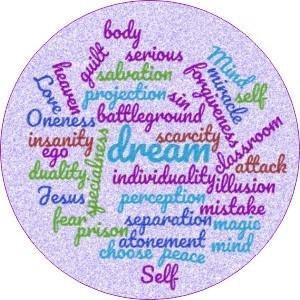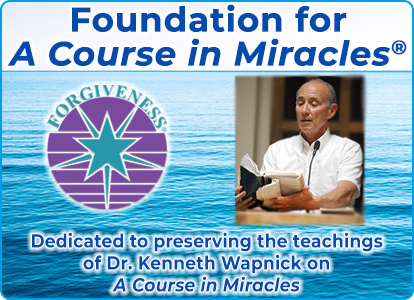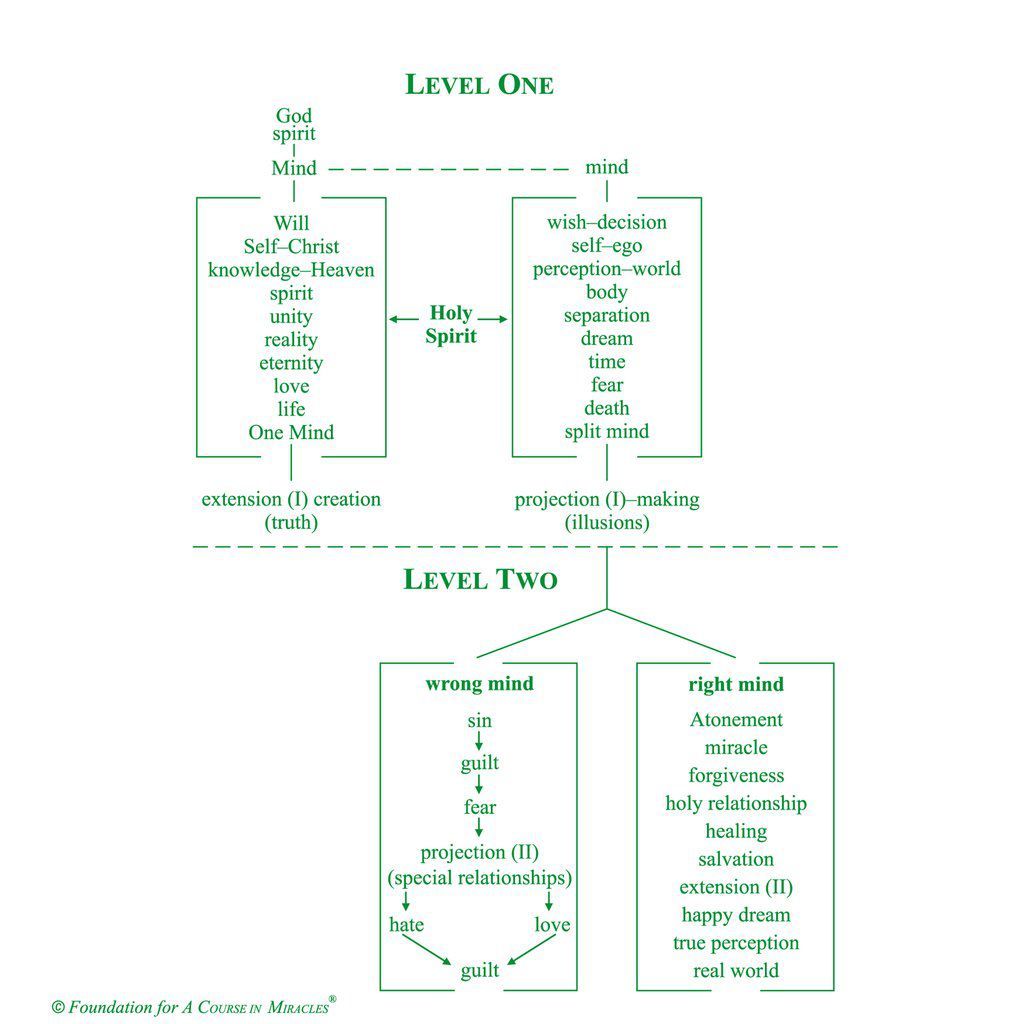Foundational Works on A Course in Miracles
by Dr. Kenneth Wapnick
Foundational Works
on A Course in Miracles
by Dr. Kenneth Wapnick

Supervised and Edited by Kenneth Wapnick, Ph.D.
Supervised and Edited by
Kenneth Wapnick, Ph.D.
Click on an excerpt, question or audio tab to open.
Click on an excerpt, question
or audio tab to open.
Best Viewed in Landscape
Q: Section T.2.VI.4:9 says, "Before you choose to do anything, ask me if your choice is in accord with mine." When I first began studying A Course in Miracles I thought this statement meant that before we did anything in this world we were to ask Jesus whether or not we should. Now, with some growth, I don't really know what the statement means (or much of anything else for that matter.) Can you elaborate?
A: The Course teaches us that since we have a split mind, there are two ways of perceiving in the dream: the ego’s and the Holy Spirit’s. They are referred to as our "teachers" or as "voices" in our mind. It also tells us that everything serves one of two goals: the ego’s or the Holy Spirit’s. Every choice we make, therefore, is in accord with one of these two perceptions, and serves one of these two goals. The statement you quote is asking us to be aware, in everything that we choose to think or do, which "teacher" we are listening to, and what purpose, or goal, our choice serves. This refers to the choice we are making in the mind, not in form. Choosing with the ego will always reinforce the belief that the separation, the world, and the body are real, and will result in some degree of conflict. The ego’s goal is to keep us in our deep sleep in the world of illusion. Choosing with the Holy Spirit will always bring peace, and strengthen our awareness that we are mind, not body. This choice leads us to the mind, so that we can learn to make the only real choice -- accepting the separation thought as real or not real.
This process has nothing to do with the "choice" we seem to be making in the world of form. Needing to make choices and decisions in the world is a helpful reminder to us that we are always choosing between the lies of the ego and the light of the Holy Spirit. The other important factor is that we must choose, there is no in between: "Vision or judgment is your choice, but never both of these" (T.20.V.4:7).
In a statement such as the one you quote, the Course is asking us to ask ourselves whether we are seeking to further our progress on our journey home to God, or whether we are seeking to reinforce our identity as a separate self. In a later chapter we are told: "In any situation in which you are uncertain, the first thing to consider, very simply, is "What do I want to come of this? What is it for?" The clarification of the goal belongs at the beginning, for it is this which will determine the outcome" (T.17.VI.2:1,2,3). In other words, "whom am I listening to?" The outcome of peace or conflict reveals who the teacher is, and also reflects what we truly want. The ultimate outcome brings us closer to the decision not to deny God or, to remain entrenched in the illusion of separation. It is important to remember that A Course in Miracles is never referring to form, and is always addressing the mind, not the body which is the figure in the dream.
Excerpted from Q&A: Detailed Answers to Student-Generated Questions on the Theory and Practice of “A Course in Miracles”
Q: What is a miracle? Although they are carefully described, I am still wondering what they are. Do they resemble what we commonly think of as miracles? Do we know when they occur, or do they happen constantly without us being aware of them? Can you give any examples of miracles?
A: First, a miracle has nothing to do with anything external. Miracles pertain only to what is going on in our own minds. In that sense, they are not at all what traditional religious systems have thought of as miracles. Traditionally, conditions in the body and the world have been viewed as the problem; and therefore miracles, simply put, were viewed as the healing or removal of those conditions, usually through some kind of divine or supernatural intervention. A Course in Miracles, on the other hand, teaches that the body and the world are projections of thoughts in our minds: “It [the world] is the witness to your state of mind, the outside picture of an inward condition... Therefore, seek not to change the world, but choose to change your mind about the world” (T.21.in.1:5,7).
Now, if you could really accept that the world is merely a projection of a thought of sin and guilt in your mind, you would realize that trying to alter things in the world or the body is ultimately futile, and that changing your mind about the reality of sin and guilt is truly healing. That is why the workbook states: “A miracle is a correction. It does not create, nor really change at all. It merely looks on devastation, and reminds the mind that what it sees is false” (W.pII.13.1,2,3). The miracle corrects our thinking, not a condition in the world or the body. Yet this passage also implies that we are not to blithely dismiss our perceptions of the world either. Rather, we are to look at the devastation in our lives, or the world-at-large, and bring that perception to the loving presence of Jesus in our minds. There, in our choosing to join with that reflection of truth, we will remember that what we are perceiving is but the content of a dream, not reality. “The miracle establishes you dream a dream, and that its content is not true” (T.28.II.7:1). Once we are joined with the reflection of truth in our minds, we would be guided solely by that in responding to the situations in our lives.
This takes a lot of practice, which is why we have a workbook with 365 lessons, at the end of which Jesus tells us that we are just at the beginning stages of this process of thought-reversal. The entire Course is about this. Our thinking right now is the reverse of what the truth is. What we are so used to calling causes are really effects. A miracle occurs when we remember and accept—for just an instant—that the cause of our and others’ lack of peace, sickness, deprivation, etc., is not something of the body or the world, but rather a choice we are making in our minds to identify with the thought system of separation and sin, guilt, and fear. “The miracle is the first step in giving back to cause the function of causation, not effect” (T.28.II.9:3).
A miracle occurs when we do not take another’s attack personally, recognizing instead that we all share the same needs and goals; we all share the same insanity of the ego, and we all share the same sanity of Christ’s vision. Sometimes we are not aware of having made that shift in our minds, sometimes we are. Miracles occur as frequently as our willingness allows them to.
Excerpted from Q&A: Detailed Answers to Student-Generated Questions on the Theory and Practice of “A Course in Miracles”
Q: I keep thinking about what A Course in Miracles refers to as the “authority” problem. I understand it to mean that there is a constant struggle within me between what I believe is the “reason” for being here and for my life, and what God “believes” is the reason for my being here and for my life. Unfortunately—like most concepts the Course teaches—I have a feeling my understanding is missing the mark. Am I even close?
A: Actually, you are not far off the mark at all. Someone once said: “If God is your co-pilot, switch seats!” Jesus tells us that the problem is much deeper than that: “The authority problem is still the only source of conflict, because the ego was made out of the wish of God’s Son to father Him. The ego, then, is nothing more than a delusional system in which you made your own father” (T.11.in.2:3,4). This obviously is insane, as Jesus himself remarks in the continuation of that passage; yet we continue to allow this conflict to rage in our minds and to project itself out all over the place in many forms, because we believe that to submit to God as our Author and Source would be a sentence of death. Or at the very least, we could not exist as we would like to.
Jesus explains
“The projection of the ego makes it appear as if God’s Will is outside yourself, and therefore not yours. In this interpretation it seems possible for God’s Will and yours to conflict. God, then, may seem to demand of you what you do not want to give, and thus deprive you of what you want.…You are afraid to know God’s Will, because you believe it is not yours. This belief is your whole sickness and your whole fear” (T.11.9:1,2,3; 10:3,4).
“The projection of the ego makes it appear as if God’s Will is outside yourself, and therefore not yours. In this interpretation it seems possible for God’s Will and yours to conflict. God, then, may seem to demand of you what you do not want to give, and thus deprive you of what you want.…You are afraid to know God’s Will, because you believe it is not yours. This belief is your whole sickness and your whole fear” (T.11.9:1,2,3; 10:3,4).
So to the extent that you value an individual, autonomous existence, you will unconsciously believe that you usurped God’s power in order to get and keep that existence and that He is coming after you to get it back. This is the one-or-the-other principle at the heart of the ego thought system, and fear is its unfortunate consequence. “To deny His Authorship is to deny yourself the reason for your peace, so that you see yourself only in segments. This strange perception is the authority problem” (T.3.VI.10.6,7).
Excerpted from Q&A: Detailed Answers to Student-Generated Questions on the Theory and Practice of “A Course in Miracles”
…Because Jesus clearly wanted Helen and Bill to pay attention to what he was dictating, he addresses their resistance to reading and studying his book—a resistance we all share, incidentally—by saying: “This is a course in mind training. All learning involves attention and study at some level.”
Jesus continues by saying that if we do not accept the groundwork of these early chapters, we will not be ready for what is to come. Rather than appropriately experiencing awe when considering the Creator, our projected guilt would lead to fear lest He punish us for our sin. The content of the later chapters is certainly difficult, for we are asked to dive into the guilt-riddled cesspool of the ego thought system, finding there the murderousness of our special relationships that is at times described in gruesome detail. In addition, the meaning of our victimhood is exposed for what it truly is: a veil drawn across the face of our victimizing self. This is why Jesus tells his first two pupils:
“You will not be able to approach this content if you do not study what I am giving you now. It is my symphony, and I beseech you to listen to it as it is written. Do not pick and choose what you like, and then discard the rest. Instead, listen to the symphony as a whole. The text is one piece, and there is a reason I say certain things now, drop them, and return to them later. Study these notes and become engaged in the learning process. While this is not an intellectual exercise, the study of this book will help the intellectual understanding convert to an experience.”
As we have observed, the text does not progress in linear fashion, for it is constructed symphonically. We do not listen to music with our heads, unless we are music critics or scholars, but with our hearts, opening them to the composer’s experience. Jesus wants that we let him lead us, as composers lead us through their work, even as our brains wrestle with the meaning of the words.
Jesus’ plea to Helen and Bill is therefore a plea to all of us to read and study these early chapters, because what follows builds upon what is here. The last movement of Beethoven’s Fifth Symphony is a glorious expression of triumph; yet, it means nothing if we have not gone through the first three movements. Similarly, many know Beethoven’s monumental Ninth Symphony only by its last movement, the inspiring variations on his theme set to Schiller’s lyrics of brotherhood. However, the music has meaning only if we have entered into Beethoven’s symphonic journey, which he conceived as a unity. And so, as serious students of A Course in Miracles, we need to go through it the way it was given. That is Jesus’ appeal to Helen and Bill, as it is his appeal to each of us.
Excerpted from Journey through the Text of “A Course in Miracles” (Introduction)
Unlike most thought systems, A Course in Miracles does not proceed in a truly linear fashion with its theoretical structure built upon increasingly complex ideas. Rather, the Course’s development is more circular with its themes treated symphonically: introduced, set aside, reintroduced, and developed. This results in an interlocking matrix in which every part is integral and essential to the whole, while implicitly containing that whole within itself.
This structure establishes a process of learning instead of merely setting forth a theoretical system. The process resembles the ascent up a spiral staircase. The reader is led in a circular pattern, each revolution leading higher until the top of the spiral is reached, which opens unto God. Thus, the same material consistently recurs, both within the Course as a thought system as well as in learning opportunities in our personal lives. Each revolution, as it were, leads us closer to our spiritual goal. The last two paragraphs of the first chapter in the text particularly emphasize this cumulative impact of the Course’s learning process.
Through careful study of the text, along with the daily practice that the workbook provides, the student is gradually prepared for the deeper experiences of God towards which A Course in Miracles points. Intellectual mastery of its thought system will not suffice to bring about the perceptual and experiential transformation that is the aim of the Course.
Excerpted from Glossary-Index of “A Course in Miracles” (Introduction)


